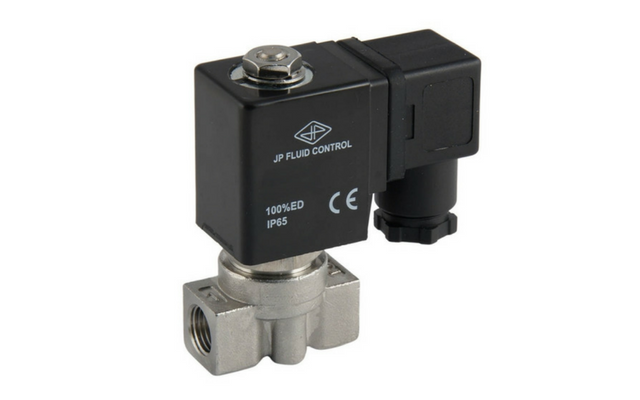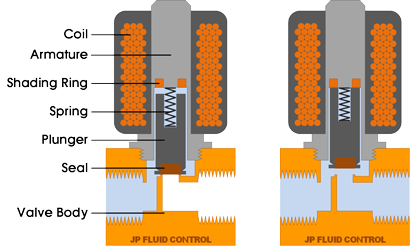Author: Tameson https://tameson.co.uk/
A solenoid valve is a crucial component to any fluid control system. They allow the user to control when, where, and how much the media moves from one step to the next. Ensuring that these valves stay up and running will keep your system up and media moving. Solenoid valves are operated by an electrical actuator (as seen in Figure 1), so that is what will be discussed in this article. However, some of the same principles can be applied to other valve types as well.
Electric Solenoid Valve Basic Principles
A solenoid valve is an electromechanically controlled valve to control the flow of a media through it. The valve has seven main features, as seen in Figure 2 showing a normally closed solenoid valve. When power is supplied to the coil (also referred to as a solenoid), it creates an electromagnetic field through the armature. The plunger is ferromagnetic and gets attracted towards the center of the field. This force overcomes the combined force of the medium pressure and the spring force. This opens up the orifice and the media is free to move through the valve body. The shading ring above the plunger is added to prevent humming sounds for AC valves. It also generates an additional magnetic field with a slight delay to ensure there is always a positive force pulling the plunger upwards during the AC cycle. When power is cut, the spring forces the plunger down and the seal closes the orifice, restricting the flow of the media. A normally open solenoid valve operates in reverse, meaning that when power is applied the plunger seals the orifice and when power is cut the spring opens the orifice.
Valve Troubleshooting
Coil
If the valve doesn’t seem to be operating when an electrical signal is sent, it is important to check your electrical connections, power supply, and the coil. The power supply needs to be sending the correct voltage and frequency to the coil. If it is, then the coil may be burnt out. To check for this, see if there are burn marks, coil is cold when powered on, or if there is 0/infinite resistance across the terminals. If you deem the coil is burnt out, you can replace the actuator portion of the valve. However, ensure that the cause of the burnt coil (over voltage, ventilation, etc.) is addressed to not have the same issue.
Particles
If your valve doesn’t open 100% or the valve is leaking, it is common that a particle inside the valve is preventing a proper seal or plunger movement. These particles (such as dirt) can cut, rust, or sand the valve seat. If able, take the valve apart and clean all components. If the particles have damaged a seal component (membrane, seal, o-ring), then these may need to be replaced individually. To ensure it doesn’t get contaminated again, check your input media and install a filter if needed.
Flow and Pressure
First and foremost, ensure that the valve was installed in the correct orientation according to the flow direction indictors on the valve body. A typical solenoid valve cannot operate properly in reverse flow. Next, ensure that the pressure of the media is within the operating limits of the valve. Certain valves, like an indirect operated valve, also need an appropriate pressure differential and cannot be used in a closed circuit or a gravity fed system.
These three failure modes cause the majority of valve down time. Often times, simply replacing a component instead of the entire valve can be done to save money. However, understanding how the valve works, what is causing the issue, and fixing the root cause of the issue will ensure it doesn’t happen again.






Aeration and Cavitation may lead to abnormal or irregular operative noise. Aeration is a condition where too much air enters the system and contaminates the hydraulic fluid within. This commonly leads to a loud banging or knocking noise from the system, when it compresses and decompresses whilst the fluid circulates through the system. Actuator movement can also become erratic and the fluid degradation can eventually damage the seals via overheating.
Cavitation commonly occurs when a hydraulic circuit demands a much higher level of fluid than is being supplied at any given time. This causes circuit pressure to fall below the level of vapor in the hydraulic fluid. The knocking sound that comes from this is caused by vapor cavities imploding during compression.
That is so interesting to find out what all goes into a fluid control system. My brother deals with these systems quite frequently, and I remember him talking about the particle issue that you mentioned. How hard would it be to replace the o-ring if it does become damaged?